A Great Hunting and Camping Knife that’s Made for Slicing not for Hacking
I love this knife and you should have it too. Full stop. End of review.
I’m going to write a bunch of other words below this sentence, but only because my girlfriend is tired of hearing me rant about my surprise at Spyderco coming out with a good hunting knife, and I need an outlet.
So here it is: Spyderco made a good hunting / camping knife, somehow.
It slices well, it carves well, it spits fire on a ferro rod, it’s comfortable in the hand, it’s well balanced, and sits light in a versatile sheath. Everything you should reasonably expect to do with a knife, the Spyderco Bill Moran does in flying colors.
It might not be so great for the crazy-person tests we normally put fixed blades through, because the edge does have a fragility problem. This knife was not made for fighting or smashing through a log with another log, but if I’m being honest, I usually only do that because it looks cool in pictures.
Specifications
| Overall Length: | 8.0″ |
| Blade Length: | 3.875″ |
| Handle Length: | 4.1″ |
| Blade Steel: | VG-10 |
| Blade Grind: | Flat |
| Blade Style: | Drop point |
| Handle Material: | FRN w/ Kraton inlays |
| Knife Weight: | 3 oz |
| Weight w/ Sheath: | 5.4 oz |
| Sheath: | Boltaron |
| Made in: | Japan |
| Price Range: | $115 |
Pros
| Sharp factory edge with a full flat grind |
| Grippy, comfortable handle |
| Sparks easy on a ferro rod |
| Feather sticks like a dream |
Cons
| Thin edge isn’t good for impact |
| Someone told me it looked like I was holding a toy |
| Handle can be tough to clean |
It’s a Moran Knife, not a Bowie
This is a review of the drop point version specifically, because I’ve never been all that comfortable with upswept blades. I do want to address the fact that the upswept version of this knife gets listed as a “Bowie” by a lot of vendors, though, because it isn’t one.
There’s not really anything about the knife that makes me want to call it a Bowie, and I’m pretty open to using that term loosely. If someone told me that Spyderco had made a Bowie knife and then showed me this thing I would look over their shoulder to look for what knife they were talking about.
I feel like the heart of the Bowie, besides the upswept or clipped point and the hand guard, is a tough knife that can be used for both hunting, fighting, and just all around hard-use survival tasks. Spyderco’s Moran “Bowie” is certainly good for hunting, but I wouldn’t put toughness in its top features (at least not in the blade), and even though it has a mean edge and point, I wouldn’t want to use it to defend myself.
Spyderco lists it on their site as either the Moran drop point or the Moran upswept. So if you hear anyone call this a Bowie you should immediately correct them, and be as annoying about it as possible. That’s what I plan on doing anyway.
Blade and Edge
This is a thin blade made for slicing. Not batoning or chopping, and that’s really important to remember in the context of so many thick-spined “hunting” knives being made as hybrid survival and skinning knives. The Spyderco Moran is for slicing and that is the range you really need to keep it in.
Everything in that range is frighteningly easy with this knife, though.
Feather Sticks and Sparks
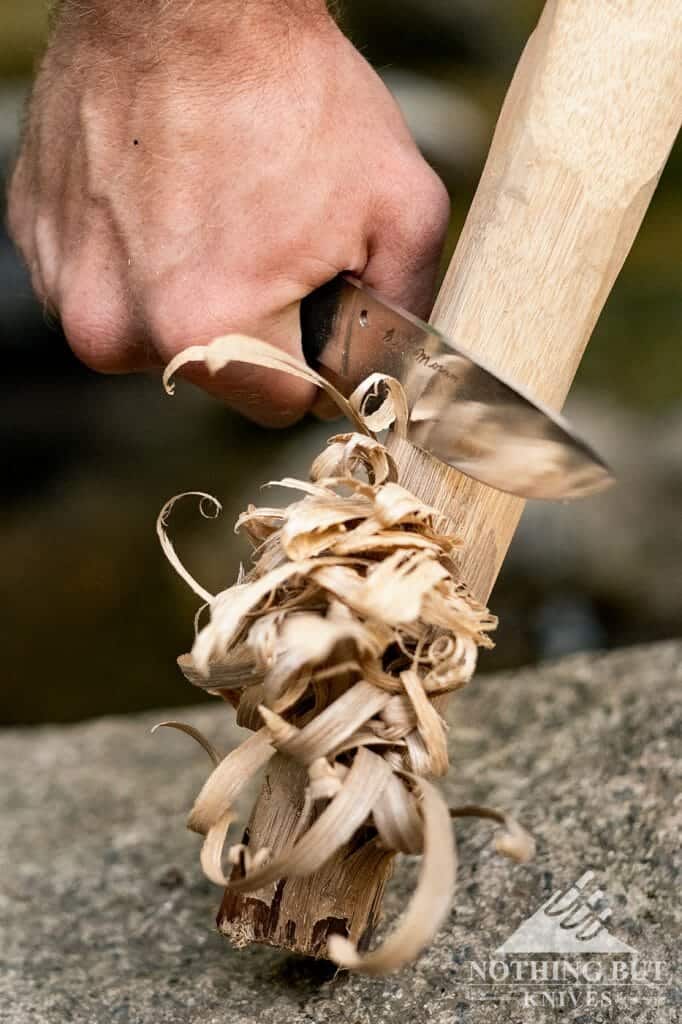
It gives you tons of control while feather sticking. I actually had to be careful how I held the knife, because it would start making curls no matter what angle I was coming in at.
When I started testing it I was ready to slam it for making shavings that were too thick, but after a couple passes I realized I just needed to get better at feather sticking. After I got used to how it cut I started making some good fuzz. And to top it off, the spine of the blade works like magic on a ferro rod. If I wanted to (and I usually do), I could send sparks flying several feet with it.
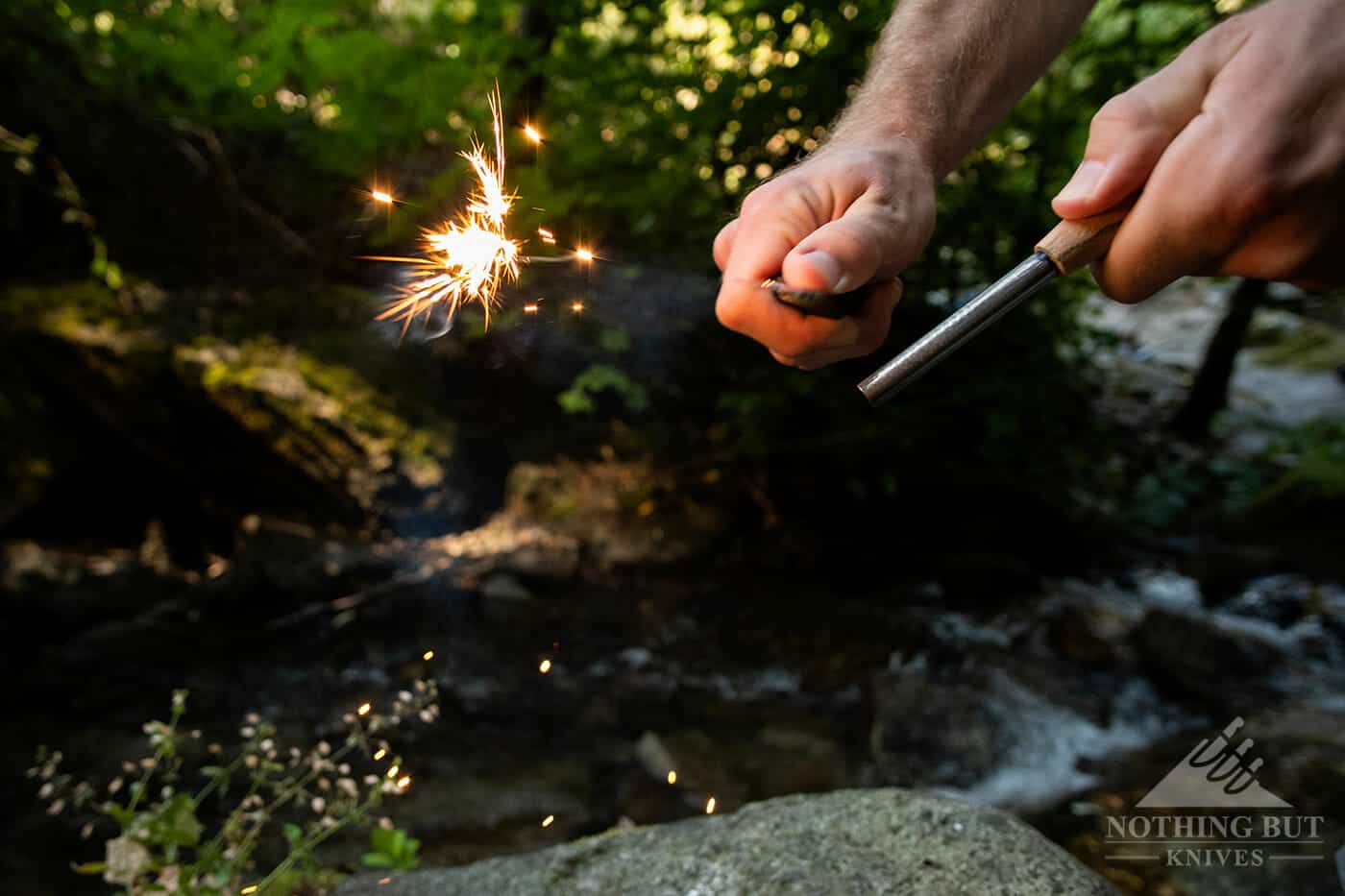
I do not recommend shooting sparks at people with it, and, for example, shouting “fireball!” over and over again, because that would be a dangerous thing to do, and you would think the novelty of it would wear off pretty quickly. I am saying, though, that it’s a physical possibility with this knife.
Slicing and Food Prep
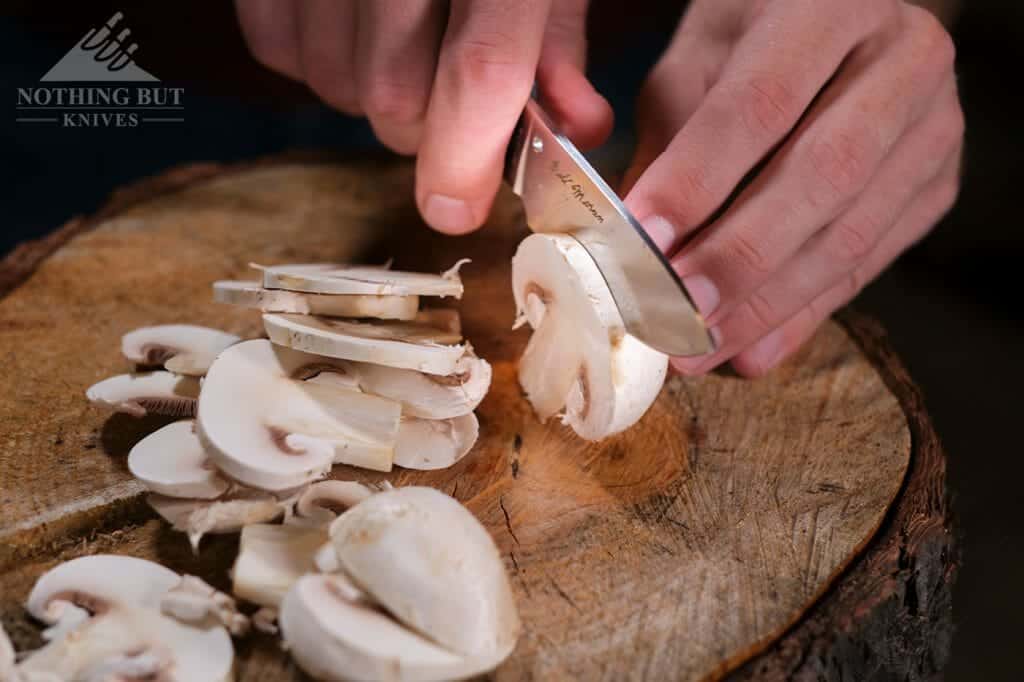
I think as a hunting knife its functionality is pretty obvious. I haven’t hunted with it but I’ve seen it sail through paper, cardboard, and both raw and cooked meat. This will handle animal skin just fine. That’s what it was designed to do.
This knife works on food better than most of my kitchen knives. It cuts tomatoes pretty thin, and I rarely have to push hard to get it to finish a cut. It’s actually become a semi-regular feature in my kitchen because I tend to wear the thing around the house when I don’t plan on going out, so it’s closer at hand than my kitchen knives.
The Thinness and Hard Steel
If the knife has a problem it’s in the potential frailness. This is a thin VG-10 steel blade, which puts it in a kitchen cutlery category of toughness. It’s thicker than most chef knives or utility knives, but the edge should be treated the same most of the time.
This has pretty good edge retention for VG-10, and it seems like they’ve gotten the grind down to where it’s about as tough as it can reasonably be, but it’s probably still going to need to be honed up after skinning something or taking it through a thorough box cutting session. The good side of that is this blade profile should be pretty receptive to a honing rod, and that should be all you’ll need to do most of the time.
As far as more extreme activity goes, you could get away with chopping with it a little, but I wouldn’t go after oak or anything. As far as batoning goes, I wouldn’t want to do more than hammer out a thin corner of a log for a bit kindling. But I also wouldn’t go to this knife as my first choice for that kind of thing. I’d use it for everything else, but not wood splitting.
Handle and Comfort
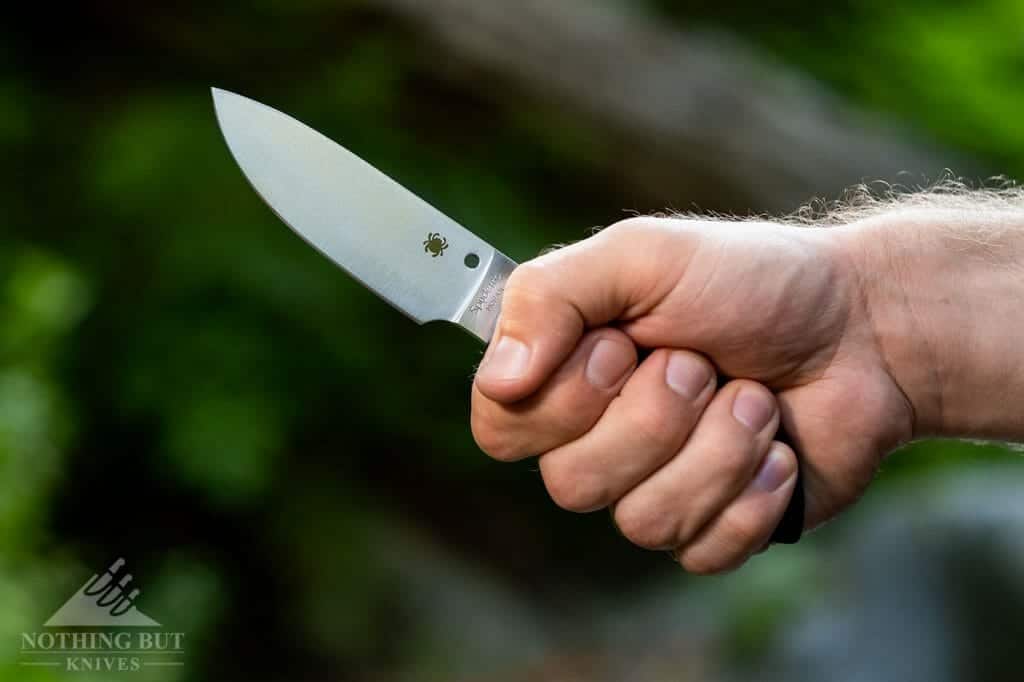
This is, for me, almost a perfect handle. It’s balanced well with the blade, the inserts are just soft enough to be grippy without dragging on the skin, and the shape of it doesn’t create hotspots. I don’t think I’ve found a way to hold this knife that feels awkward or uncomfortable. It’s a lot like a Morakniv in that way.
The Plastic and Rubber Synergy
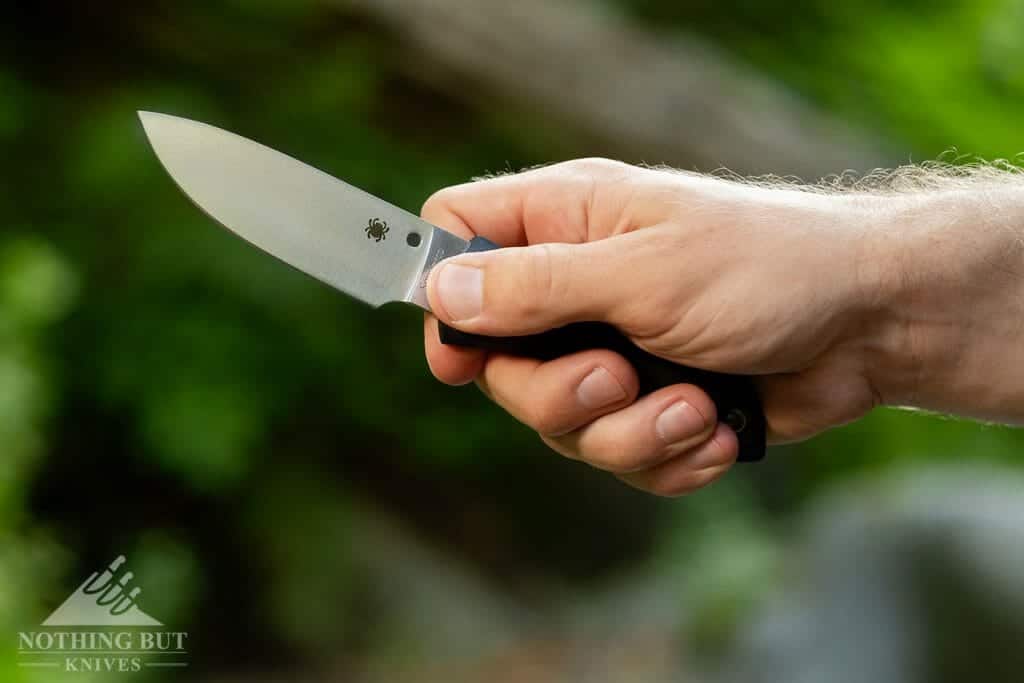
They’ve managed the combination of FRN and Kraton really well. The rubber inserts are wide enough that they provide good friction and padding while the FRN plastic around it has a nice smooth feeling along the palm in a full standard grip. All the important parts of this knife have good traction, including that little pad near the top of the handle where jimping would normally go.
Choking It Up
Even the finger choil is well done. The edge is ground away from the handle just right so that the finger doesn’t get poked or cut, and the way the top of the handle curves in makes a mostly comfortable resting spot for the index finger. Doing any kind of detail work with the tip of the blade feels pretty secure holding the knife this way. I have a lot of control, and have yet to worry about my hand slipping off the handle.
The Small Discomforts
The way the handle curves and swells at the bottom does make the fingers feel a bit cramped, though, and it pushes my pinky and fourth finger forward a little bit when I choke the blade up. It’s almost uncomfortable, but only when I’m paying attention. As soon as I start using the knife, that feeling disappears.
The other possible issue is that the pinch grip feels too wide even though they’ve made a couple of nice slanting grooves for the fingers. It’s not quite enough for a good pinch grip. I’m tempted to say they should have done something like the Gerber Principle and put in plastic inserts that could thin out more onto the blade, but that might have created the Principle’s issue where the material is too thin and risks wearing off too soon.
As it is, the wide pinch grip isn’t an issue that interferes with the functionality of the knife. I’m just nitpicking at this point.
Sheath and Ergonomics
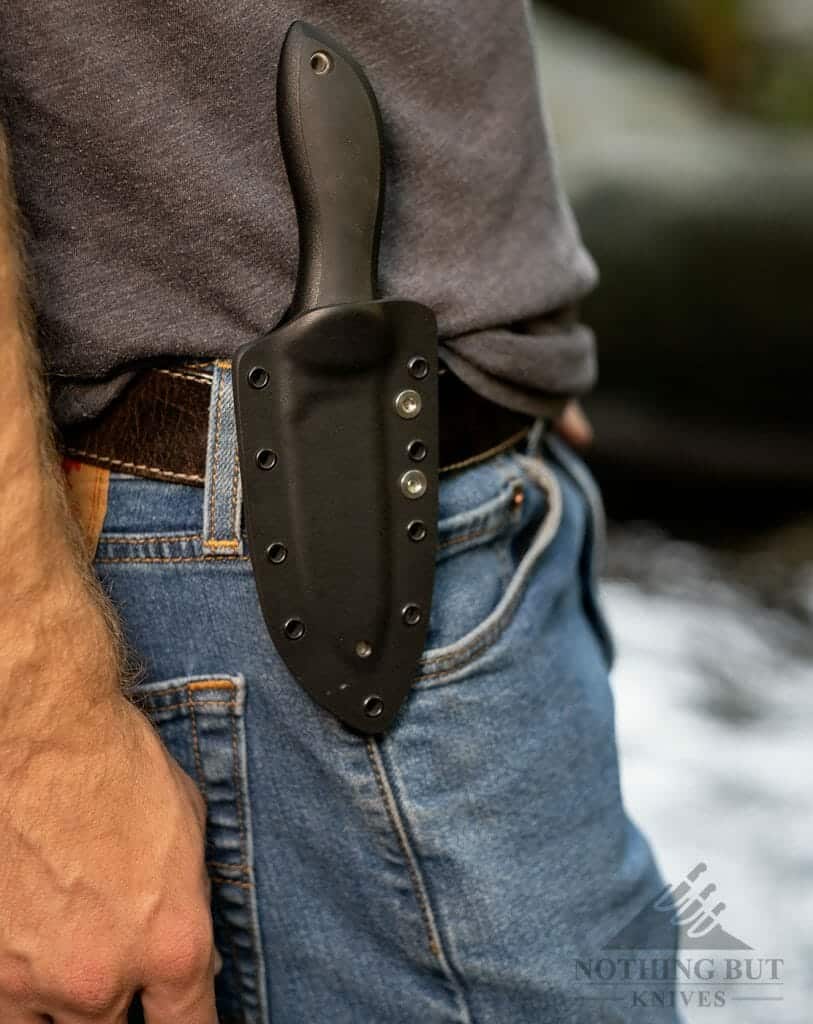
This knife carries and deploys really well thanks to it being so well balanced and the handle being comfortable in every direction. It’s also fairly compact for a fixed blade, so it rides easy on the belt.
A Good Scout Carry knife
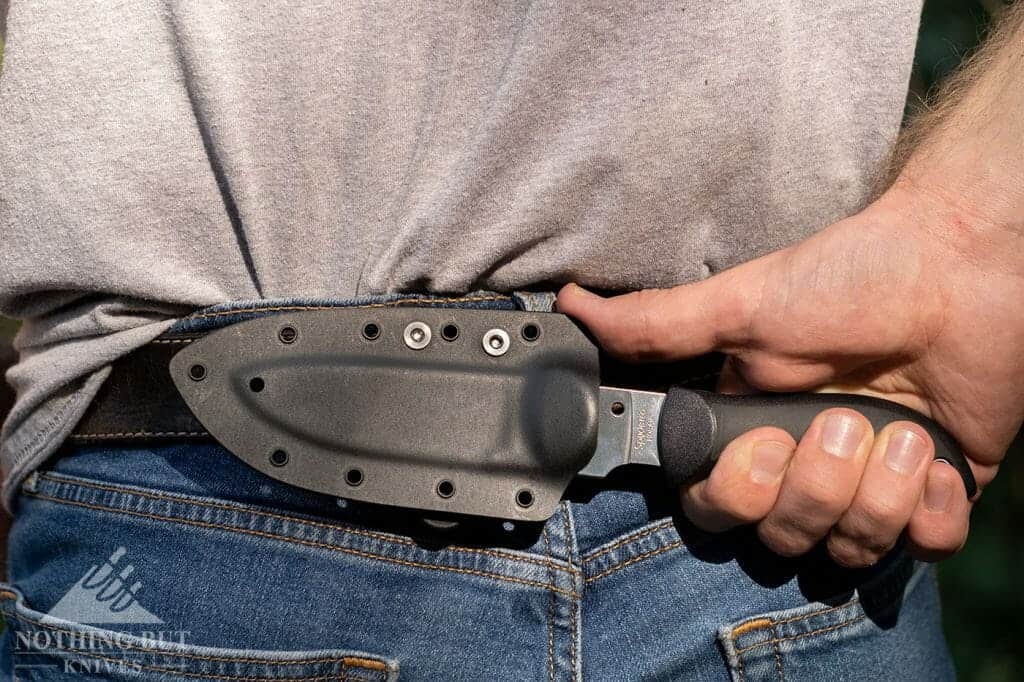
Spyderco was kind enough to make this adaptable to left, right, vertical, and horizontal carry. It rides a little too high vertically for me, and the butt forms into a sort of point that can jab the ribs pretty good unless you’re a much taller person than me.
It works really well as a horizontal carry, though. It’s actually one of the few knives I don’t have trouble putting back in the sheath as a scout carry. There’s something about the size and weight that just makes it feel a lot more natural than other fixed blades that are either too light, long, or heavy.
The Good Balance
The fact that this knife has essentially the same sheath design as the Spyderco Ronin 2 really highlights how well balanced the Spyderco Moran is. The Ronin is well balanced as a knife in the hand, but it can get lopsided on the belt. The Moran is both light in the handle and thin on the blade, so it feels pretty natural no matter where you wear it. But also its center of gravity sits a lot closer to the G-clip when it’s horizontal, so it feels very steady.
The only gripe I have with the sheath, besides it not being compatible with Tek Lok (but I complained about that enough with the Ronin), is that I wish they had added some kind of loop for a ferro rod. It sparks so well that starting fires could easily become a common task for the knife. It would be nice to have both rod and knife equally close at hand.
Purpose and Designer
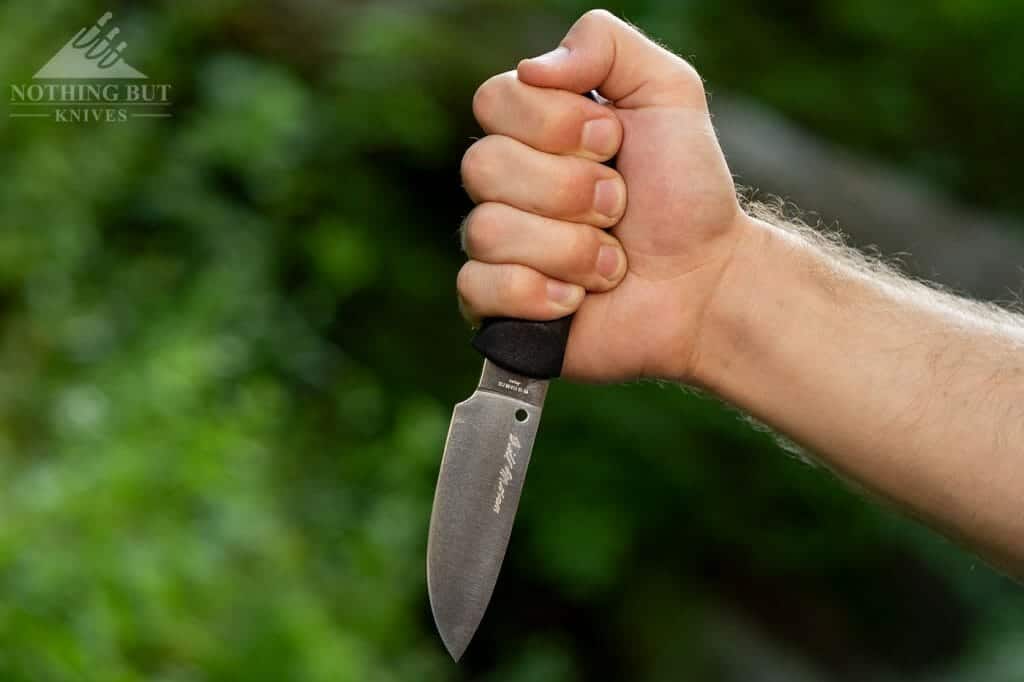
I’m not going to be able to tell you anything about Bill Moran that a thousand other knife designers and magazines couldn’t. He founded the American Bladesmith Society and the Bill Moran School of Bladesmithing. He’s the reason at least half the custom designers out there right now started in the first place.
This is not the kind of knife he’s famous for designing, though. He made his name on Damascus steel blades and big Bowie knives you could stab through a wall. On the spectrum of Moran knives, the Spyderco Moran is oddly humble and simplistic, and I think that’s because it was made specifically with a hunting trip in mind. This knife skins, carves, and spits fire, and it doesn’t need outrageous stylistic innovations or super steels to do that. It just needs good steel, a comfortable handle, and a decent edge, and that’s all it got.
On Spyderco Making a Hunting Knife
This seems way out of Spyderco’s wheelhouse. They’re famous for making folders mostly carried by nerds who think they need perfectly tempered S30V steel to open the boxes that their new Solid State drives come in.
At least, that’s how I’ve always seen them.
I’ve come to realize I shouldn’t be that surprised, though. When Spyderco wants to make a specialized knife, they tend to go about in a very practical way: they get someone who does the thing to design a knife that helps them do that thing better. This knife has made me realize that they maybe don’t get enough credit for how they make task specific knives. Or, at least, how I don’t give them enough credit.
Their Salt series is probably the best example of this. Most of those knives are designed by actual divers and sailors who drew something up to answer a need they specifically had, whether that was having a corrosion resistant knife that could hold an edge, or something that could cut special materials underwater. The Ronin 2 has a similar story behind it (and all Janich’s designs for that matter). He wanted a knife that could cut and fit the hand in a very specific way for his purposes as a martial artist, and Spyderco did a good job of working with him to make that work on a mass produced level.
This Moran design seems to answer a problem of not having a hunting knife made of modern materials that was more or less dedicated to just that: hunting. And it says a lot about Spyderco that they can step away from their usual run of fancy folders to really focus on making designs like this well.
Comparison and Alternatives
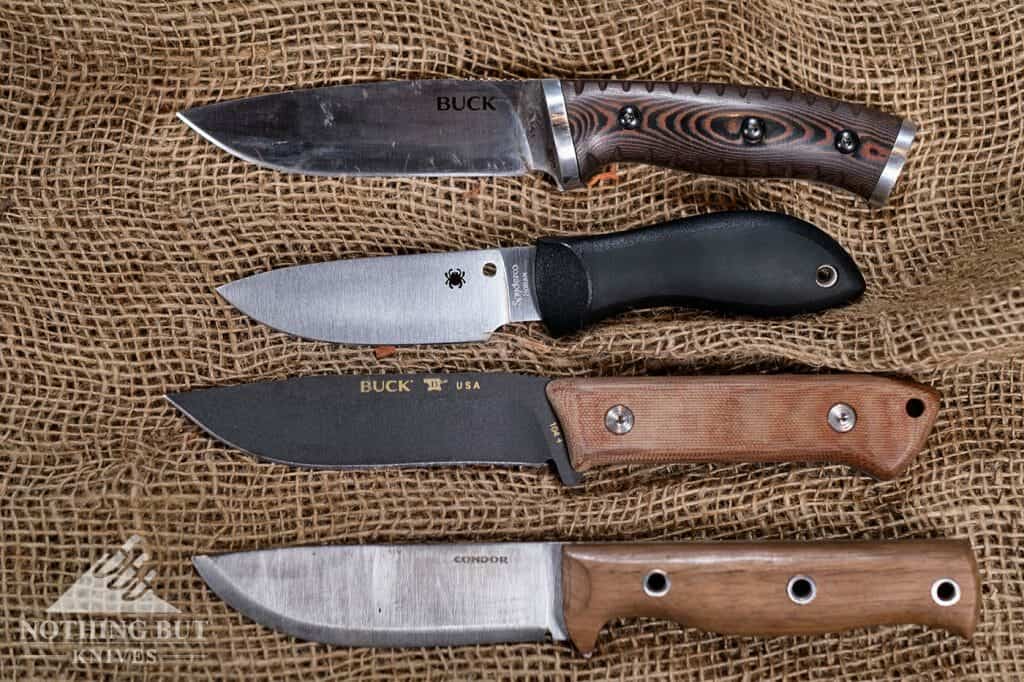
If I’m being totally honest, the price for the Spyderco Moran is probably a little higher than it should be. I think if it didn’t have Bill Moran’s name it would be more in the $80 range. For a knife with VG-10 steel and a plastic handle, that really feels like the right spot. So it’s awkward to say that all my alternative recommendations are less expensive and arguably just as functional, but I still don’t like any of them as much as I like this knife. So maybe there’s something to having a Bill Moran design.
Regardless, it’s worth checking out these other knives if you’re on the fence:
I bring this knife up a lot, but the Buck Slekirk feels like an especially relevant comparison to the Moran Bowie. They have similar blade shapes, sizes, and overall function. But where the Spyderco has nicer steel, and a more comfortable handle, the Selkirk is a lot tougher, and comes at half the price.
If you want something a lot sturdier and a bit bigger, the Buck Compadre can do a lot of the same things the Moran can, and I would put them on almost equal ground where ergonomics are concerned. With the Compadre you have a lighter price tag, but that comes with a low end tool steel that you’re going to have to sharpen and hone up a lot.
The Gerber Principle is possibly the toughest alternative, but you’d be sacrificing a lot of slicing ability for toughness and cost. The Principle is much more of a bushcraft survival knife knife that you can beat up both before and after skinning a boar, and the edge will be basically the same. But the edge will never cut like the Moran Bowie can no matter how much you sharpen it.
The Condor Swamp Romper runs in that same vein. It’s a highly versatile bushcraft knife that would be good for hunting, and I would even say it looks a lot nicer than the Spyderco Moran and comes at a better price point, but it’s not specialized like the Spyderco. You can’t really choke up on it, and the pinch grip is more awkward. Plus the sheath is only vertical carry and flops around a lot, while the Moran becomes almost nonexistent on the belt.
Conclusion
Yes. Get this knife. If you need a fixed blade for anything other than hardcore bushcraft, and your budget is in the $100 range, the Spyderco Bill Moran should absolutely be at the top of your list.
More specifically you should consider it if you plan on hunting or camping. This knife can take you all the way through skinning and rendering game, making tinder, starting a fire, and chopping up food with whatever miscellaneous slicing tasks you have in between. So long as you don’t pound the blade into things, it’s a solid companion. The only thing I would suggest is that if you plan on being out in the wilderness for a while, it might be worth packing some kind of honing rod or sharpening kit just to get the edge realigned every now and then.
